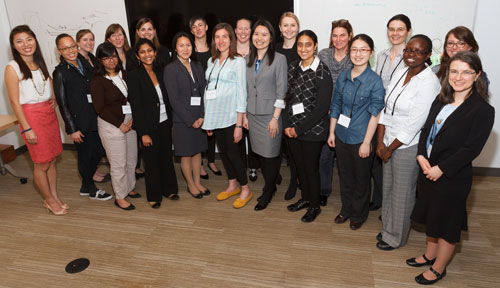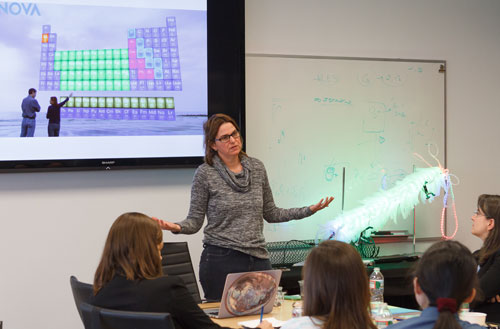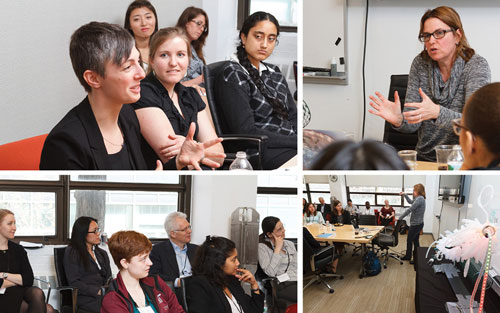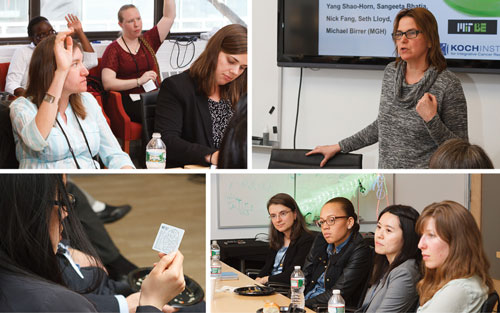2015 Rising stars in nuclear science and engineering

On April 15, 2015, the 2nd biennial Rising Stars in Nuclear Science and Engineering Symposium continued a conversation about two important topics: the multidisciplinary nature of the field, and the work that still needs to be done to increase the representation of women in the discipline. "Rising Stars in Nuclear Science and Engineering addresses one of the biggest challenges in our field,” says Professor Richard Lester, Head of the Department of Nuclear Science and Engineering. “One of the most important things we can do is to encourage outstanding women scientists and engineers to enter and to remain in our field. Rising Stars contributes to that goal. It provides an opportunity to celebrate the research accomplishments of a new generation of women doctoral and post-doctoral researchers, and to create new professional networks that will support the progress of these outstanding young women throughout their careers."
The symposium was planned by NSE Professors Paola Cappellaro, Anne White and Bilge Yildiz, and featured female graduate students, post-doctoral researchers, scientists and professors from across the United States. The day centered around research talks given by the attendees, with topics ranging from material science to radiation detection, reactor physics, and high performance computing. Nina Lanza, a research scientist from Los Alamos National Laboratory currently working on the Curiosity Rover mission on Mars, brought a unique research perspective based on her experiences working in a large multidisciplinary team. Her research focuses on the elemental analysis of Martian rock and soil performed using ChemCam, an instrument that combines laser-induced breakdown spectroscopy with a high-resolution camera. Preliminary results at the rover’s landing site shows evidence of past habitability on Mars.
Lakshana Huddar, a doctoral candidate from University of California, Berkeley presented her research on heat transfer in pebble bed nuclear reactor cores cooled by fluoride salt. Huddar explained her approach of using a scaled laboratory experiment based on simulant oils that match key non-dimensional parameters expected in the pebble bed reactors to estimate the heat transfer coefficient between the coolant and the pebble fuel. This research is necessary to accurately predict fuel temperatures in this advanced reactor core.
A subgroup of presenters focused on particle simulation techniques. Pi-En Tsai, a doctoral candidate from the University of Tennessee, introduced her experimental measurements and simulations of secondary neutrons from high-energy helium ion interactions with a variety of stopping materials. Using the Heavy Ion Medical Accelerator facility at the National Institute of Radiological Sciences in Chiba, Japan, Tsai determined the neutron energy spectra. She used particle transport codes to reproduce the experiments in simulation; improvements in the simulation fidelity of these experiments will help in predicting the energy spectra of these secondary neutrons.
The Rising Star audience was made up of students, faculty and staff from across the Nuclear Science and Engineering Department and the MIT community at large, as well as the Rising Stars group itself. This broad composition made for very exciting and penetrating Q&A sessions. Audience members drew on their own expertise when exposed to new research topics, which was illustrated by the detailed transport simulation discussions between detector designers, reactor physicists, and material scientists. “What really stood out for me was the breadth of research that's related to nuclear science and engineering,” said Prof. White. "This amazing group of young scientists exemplifies the multidisciplinary nature of nuclear science and engineering.”
Angela Belcher, the W.M. Keck Professor of Energy and a faculty member in Materials Science and Biological Engineering, was the keynote speaker for the symposium. Prof. Belcher opened her talk by handing out tiny cards of the periodic table that remind the recipients that they’re in their element. This set the stage for her talk, which highlighted projects throughout her career that grew out of her interest in chemistry and materials, ranging from her first bacteriophage-based battery to new projects focused on a novel platform for cancer imaging.

Prof. Belcher, who seamlessly wove career and life-balance advice into her talk, responded to a question saying, “there’s no balancing...it really is stopping one thing and doing something else...for me, my kids always come first.” When discussing managing her roles as a faculty member, research advisor, entrepreneur and mother she added, “I think the great thing about this job is that you can have it all, but not all at one time.” She also elaborated on the importance of childcare and a good support network for mothers in professional settings.
Many symposium participants appreciated the honesty and practical advice. Later one of the participants, Dr. Kasturi Saha, reflected that “events like these bring up a lot of things which you wouldn’t normally discuss, things that you are faced with on a day-to-day basis but you do not want to talk about a lot of the time.”
During a panel session on “Work-Life Balance — How to Thrive as a Junior Professor,” attendees asked questions about the path to becoming a professor and the increased duration of post-doctoral positions. When asked how to find a faculty position Prof. Yildiz responded, “do what you’re motivate to do, it’s a natural progression.” Other topics during the panel session included the importance of mentorship, networking, communication, and negotiation during the hiring process.
At the end of the day NSE PhD student Mareena Robinson-Snowden commented, “The quality of this symposium is top par...we’re all getting to know each other and I’m very appreciative of these types of events. I just wish they didn’t have to be only every two years.”


- NSE Rising Stars symposium offers young women researchers rare opportunity
- 2015 NSE Rising Stars
- Angela Belcher
- Paola Cappellaro
- Anne White
- Bilge Yildiz
“It was very encouraging to see the number of brilliant female researchers in the field and the quality of the work that was presented. The environment was very open even if most of us have not met each other before. I benefited intellectually by learning new information from the presentations and socially by being able to bond with other female members of the community!”
—Lulu Li
“These kind of events help you to open up and try to understand the situation and address the issues we face as women...there are gender biases which nobody wants to talk about. These kinds of events are helpful because they allow you to discuss with like-minded people.”
—Kasturi Saha
“The symposium was an extremely positive experience, and meeting so many talented engineers and scientists was fantastic. The depth and variety of the presentations was astounding, and I learned a lot from every symposium attendee. Nuclear engineering is a very multidisciplinary field, and this will only increase over the coming years in order to combat sustainable energy production challenges.”
—Lakshana Huddar
Written by Brittany Goods and Mareena Robinson-Snowdon
Photos by Russ Campbell
Photo 1: NSE Rising Stars participants with NSE graduate students; Photo 2: Keynote speaker Professor Angela Belcher; Photo 3 & 4: Networking
